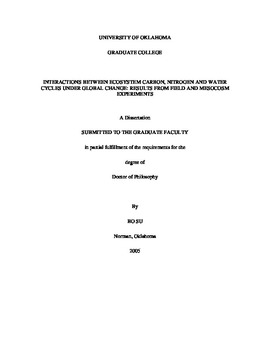| dc.contributor.advisor | Luo, Yiqi, | en_US |
| dc.contributor.author | Su, Bo. | en_US |
| dc.date.accessioned | 2013-08-16T12:19:48Z | |
| dc.date.available | 2013-08-16T12:19:48Z | |
| dc.date.issued | 2005 | en_US |
| dc.identifier.uri | https://hdl.handle.net/11244/868 | |
| dc.description.abstract | N additions increased NEE by enhancing light interception, RUE, and extending growing seasons. Different N application methods (PF versus GF) caused differential seasonal dynamics of LAI, NEE and RUE due to their different N supply doses during different growth periods. N fertilization stimulated evapotranspiration primarily by extending growing season. N fertilization enhanced photosynthesis more than evapotranspiration, causing higher ecosystem WUE. Different fertilization methods changed the seasonal dynamics of WUE due to their differential effects on gross ecosystem photosynthesis. | en_US |
| dc.description.abstract | Little is known about how climate warming, land-use change and N fertilization/deposition affect ecosystem carbon (C), nitrogen (N) and water cycles. By reducing plant C substrate input via cutting aboveground biomass and shading, I investigated how plant C supply affects soil N dynamics in a tallgrass prairie. By incubating litter bags in the field, I studied the effects of warming and clipping on litter decomposition and N dynamics of 3 litter species. By measuring whole-ecosystem CO2 and water fluxes of a model grassland ecosystem, I investigated whether N fertilization (simulated by pulse N fertilization) and deposition (mimicked by gradual N fertilization) increase NEE, radiation-use efficiency (RUE), ET, and water-use efficiency (WUE). | en_US |
| dc.description.abstract | Warming and clipping together significantly altered the mass remaining percentage of S. scoparium shoot litter, with the treatment effects being mainly caused by clipping. Warming and clipping did not affect the net nitrogen (N) immobilization/release of the 3 litter types. However, the decay constant k and N remaining percentages differed among the 3 litter types due to their different initial litter quality. Warming reduced whereas clipping increased the in situ litter quality, suggesting a potential impact on the long-term ecosystem C and N cycles. | en_US |
| dc.description.abstract | Biomass removal (BR) and shading (S) increased soil inorganic N, likely due to the severed plant N uptake and reduced microbial N immobilization. Shading increased net N mineralization and nitrification probably by reducing microbial N immobilization. Soil respiration, together with soil microclimate, accounted for 27--38% additional variations in NH4 +-N, net N mineralization and nitrification rates than soil microclimate alone, suggesting an important role of plant C supply in regulating NH 4+-N, net N mineralization and nitrification rates. | en_US |
| dc.format.extent | xv, 145 leaves : | en_US |
| dc.subject | Ecological disturbances. | en_US |
| dc.subject | Global environmental change. | en_US |
| dc.subject | Biogeochemistry. | en_US |
| dc.subject | Biology, Ecology. | en_US |
| dc.subject | Photosynthesis. | en_US |
| dc.subject | Carbon cycle (Biogeochemistry) | en_US |
| dc.subject | Biology, Botany. | en_US |
| dc.title | Interactions between ecosystem carbon, nitrogen and water cycles under global change: Results from field and mesocosm experiments. | en_US |
| dc.type | Thesis | en_US |
| dc.thesis.degree | Ph.D. | en_US |
| dc.thesis.degreeDiscipline | Department of Microbiology and Plant Biology | en_US |
| dc.note | Adviser: Yiqi Luo. | en_US |
| dc.note | Source: Dissertation Abstracts International, Volume: 66-02, Section: B, page: 0683. | en_US |
| ou.identifier | (UMI)AAI3164558 | en_US |
| ou.group | College of Arts and Sciences::Department of Microbiology and Plant Biology | |
